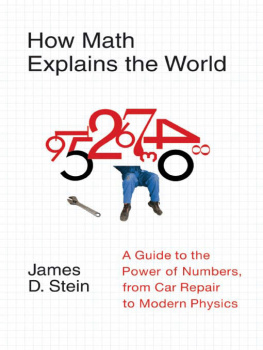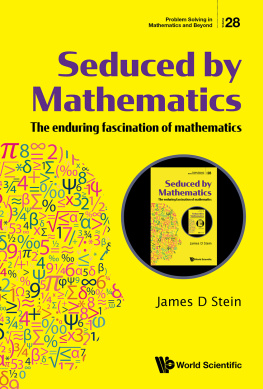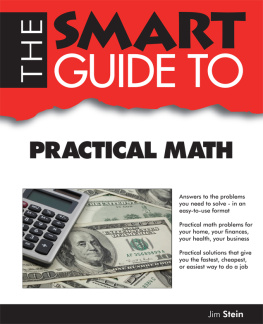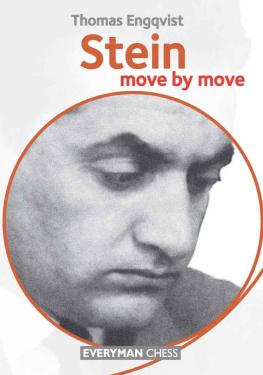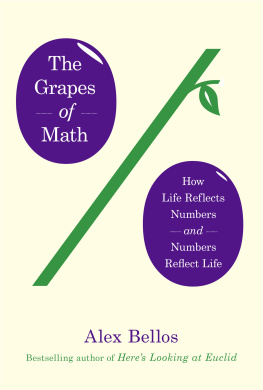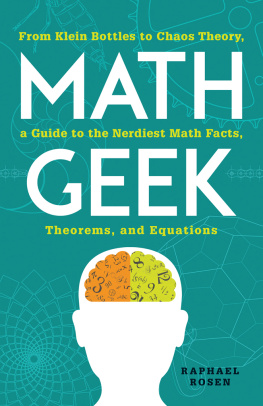To my lovely wife, Linda,
for whom no dedication does justice.
Contents
The November Statement
My first glimpse into mathematics, as opposed to arithmetic, came on a Saturday afternoon in late fall when I was about seven years old. I wanted to go out and toss a football around with my father. My father, however, had other ideas.
For as long as I can remember, my father always kept a meticulous record of his monthly expenses on a large yellow sheet that, in retrospect, was a precursor of an Excel spreadsheet. One yellow sheet sufficed for each month; at the top, my father wrote the month and year, and the rest of the sheet was devoted to income and expenses. On this particular fall day, the sheet had failed to balance by 36 cents, and my father wanted to find the discrepancy.
I asked him how long it would take, and he said he didnt think it would take too long, because errors that were divisible by 9 were usually the result of writing numbers down in the wrong order; writing 84 instead of 48; 84-48=36. He said this always happened; whenever you wrote down a two-digit number, reversed the digits, and subtracted one from the other, the result was always divisible by 9.1
Seeing as I wasnt going to be able to toss a football around for a while, I got a piece of paper and started checking my fathers statement. Every number I tried worked; 72-27=45, which was divisible by 9. After a while, my father found the error; or at least decided that maybe he should play football with me. But the idea that there were patterns in numbers took root in my mind; it was the first time that I realized there was more to arithmetic than the addition and multiplication tables.
Over the years, I have learned about mathematics and related subjects from four sources. In addition to my father, who was still attending Sunday-morning mathematics lectures when he was in his seventies, I was fortunate to have some excellent teachers in high school, college, and graduate school. When the Russians launched Sputnik in 1957, schools scrambled desperately to prepare students for careers in science and engineering; the Advanced Placement courses took on added importance. I was in one of the first such courses, and took a wonderful course in calculus my senior year in high school from Dr. Henry Swain. One of my regrets is that I never got a chance to tell him that I had, to some extent, followed in his footsteps.
In college I took several courses from Professor George Seligman, and I was delighted to have the opportunity to communicate with him as I was writing this book. However, the greatest stroke of good fortune in my career was to have Professor William Bade as my thesis adviser. He was not only a wonderful teacher, but an inspired and extremely tolerant mentor, as I was not the most dedicated of graduate students (for which I blame an addiction to duplicate bridge). The most memorable day of my graduate career was not the day I finished my thesis, but the day Bill received a very interesting and relevant paper.2 We met at two and started going over the paper, broke for dinner around 6:30, and finished, somewhat bleary-eyed, around midnight. The paper itself was a breakthrough in the field, but the experience of going through it, discussing the mathematics and speculating on how I might use it to develop a thesis, made me realize that this was something I wanted to do.
There are a number of authors whose books had a profound effect on me. There are too many to list, but the most memorable books were George Gamows One, Two, ThreeInfinity, Carl Sagans Cosmos, James Burkes Connections, John Castis Paradigms Lost, and Brian Greenes The Elegant Universe and The Fabric of the Cosmos . Only two of these books were published during the same decade, which attests to a long-standing tradition of excellence in science writing. Id be happy if this book was mentioned in the same breath as any of the above.
Ive had many colleagues over the years with whom Ive discussed math and science, but two in particular stand out: Professors Robert Mena and Kent Merryfield at California State University, Long Beach. Both are excellent mathematicians and educators with a far greater knowledge and appreciation of the history of mathematics than I have, and writing this book was made considerably easier by their contributions.
There have been several individuals of varying technical backgrounds with whom I have had illuminating conversations. My understanding of some of the ideas in this book was definitely helped by conversations with Charles Brenner, Pete Clay, Richard Helfant, Carl Stone, and David Wilczynski, and I am grateful to all of them for helping me to think through some of the concepts and devising different ways of explaining them.
Finally, Id like to thank my agent, Jodie Rhodes, without whose persistence this book may never have seen the light of day, and my editor, T. J. Kelleher, without whose suggestions both the structure and the presentations in this book would have been much less coherentT.J. has the rare gift of improving a book on both the macro and the micro level. And, of course, my wife, Linda, who contributed absolutely nothing to the book, but contributed inestimably to all other aspects of my life.
NOTES
- Any two-digit number can be written as 10 T + U, where T is the tens digit and U the units digit. Reversing the digits gives the number 10 U + T, and subtracting the second from the first yields 10 T + U -(10 U + T )=9 T -9 U =9( T-U ), which is clearly divisible by 9.
- B. E. Johnson, Continuity of Homomorphisms of Algebras of Operators, Journal of the London Mathematical Society, 1967: pp. 537541. It was only four pages long, but reading research mathematics is not like reading the newspaper. Although it was not a technically difficult paper (no involved calculations, which can slow down the pace of reading to a crawl), it contained a number of incredibly ingenious ideas that neither Bill nor I had seen before. This paper essentially made my thesis, as I was able to adapt some of Johnsons ideas to the problem that I had been addressing.
Not Just a Rock
We advance, both as individuals and as a species, by solving problems. As a rule of thumb, the reward for solving problems increases with the difficulty of the problem. Part of the appeal of solving a difficult problem is the intellectual challenge, but a reward that often accompanies the solutions to such problems is the potential to accomplish amazing feats. After Archimedes discovered the principle of the lever, he remarked that if he were given a lever and a place to stand, he could move Earth.1 The sense of omnipotence displayed in this statement can also be found in the sense of omniscience of a similar observation made by the eighteenth-century French mathematician and physicist Pierre-Simon de Laplace. Laplace made major contributions to celestial mechanics, and stated that if he knew the position and velocity of everything at a given moment, he would be able to predict where everything would be at all times in the future.
Given for one instant an intelligence which could comprehend all the forces by which nature is animated and the respective positions of the beings which compose it, if moreover this intelligence were vast enough to submit these data to analysis, it would embrace in the same formula both the movements of the largest bodies in the universe and those of the lightest atom; to it nothing would be uncertain, and the future as the past would be present to its eyes.2
Of course, these statements were rhetorical, but they were made to emphasize the far-reaching potential of the solution to the problem. A casual onlooker, seeing Archimedes use a lever to reposition a heavy rock, might have said, OK, thats useful, but its just a rock. Archimedes could have replied, Its not just this rockits any object whatsoever, and I can tell you what length lever I need to move that object and how much effort I will have to exert in order to move the object to a desired position.

